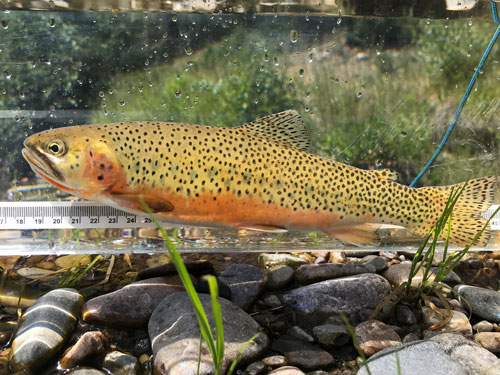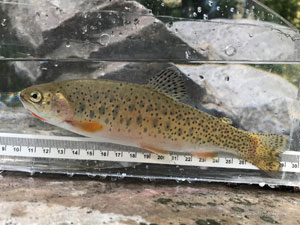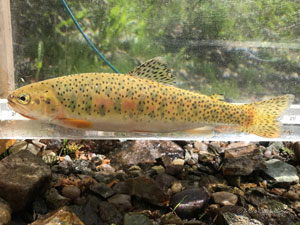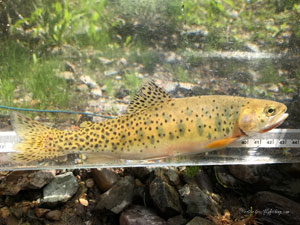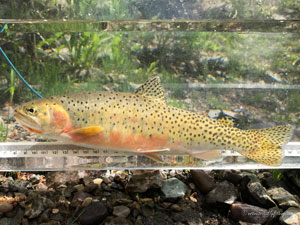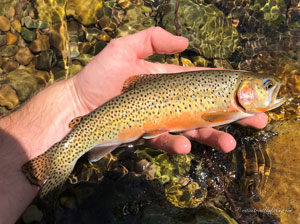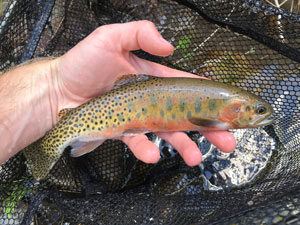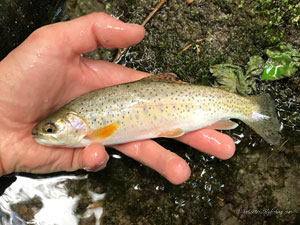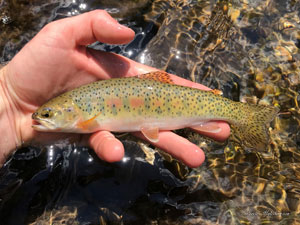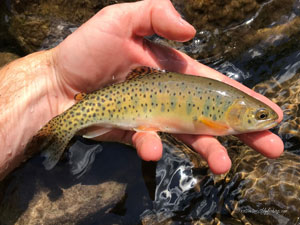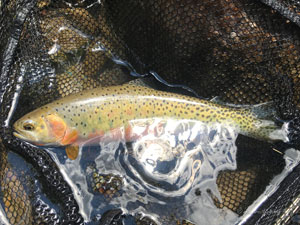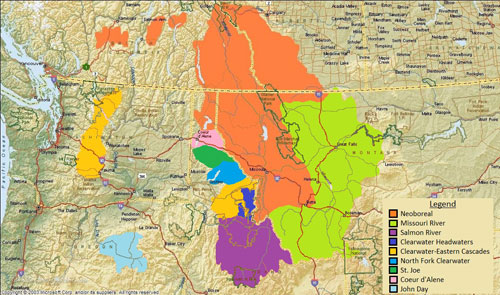Salmon River Westslope Cutthroat
Oncorhynchus lewisi ssp.
A stream resident Salmon River Westslope Cutthroat from an Idaho stream.
Introduction
The Salmon River Westslope Cutthroat are native to the Salmon River watershed in central Idaho, which holds some of the most robust Westslope Cutthroat populations across the range of the species (Shepard et al. 2005). There are two unique genetic lineages of Westslope Cutthroat within this watershed, with one primarily in the lower basin and the other in the upper basin (Young et al. 2018). It is likely that these two groups were isolated in different parts of the basin during the last ice age and have mixed since. As there is no clear line of delineation between these two groups but instead a transitional zone, all Salmon River Westslope Cutthroat are considered a single subspecies (Trotter et al. 2018). Genetically the Salmon River Westslope Cutthroat are most closely related to the North Fork Clearwater Westslope Cutthroat subspecies (Young et al. 2018).
Life History Information
The Salmon River Westslope Cutthroat Trout exhibit stream resident, fluvial (river migrant) and adfluvial (stream to lake migrant) life history strategies. Little is known about adfluvial Salmon River Westslope Cutthroat, which are believed to have been extirpated from all of the lakes that once held them. However, it is believed that their behavior is similar to that of other Westslope Cutthroat subspecies and in the one population in Yellow Belly Lake that has been observed, adfluvial Westslope Cutthroat typically forage nearshore areas throughout the day before moving into offshore into deeper waters holding on the bottom of lakes at night (Beauchamp et al. 1997).
Stream resident populations are primarily drift feeders preying on aquatic and terrestrial insects and only reach a maximum size of around 12” (30 cm) (Trotter 2008). In general stream resident fish have small home ranges and are typically found in tributaries. In contrast the fluvial life history form migrate may long distances with fish documented moving 295 miles (475 km) throughout the Salmon River watershed (Zurstadt 2004). A study on the Middle Fork of the Salmon River showed that most Cutthroat in the basin were highly migratory with only 25.3% of fish being recaptured within 1 mile of where they were initially tagged. Fluvial Salmon River Westslope Cutthroat typically reach a maximum size of ~18” (46 cm) and their diet is dominated by invertebrates. A study on the Salmon River upstream of Panther Creek showed that 89% of the diet between March and November was aquatic invertebrate, 10% was terrestrial invertebrates and fish made up <1% (Schoby and Keeley 2011). Studies on the Middle Fork Salmon River have shown that snails are prominent in Cutthroat diets accounting about one third of the trout’s diet, with aquatic invertebrates, eggs and fish making up the remained of the diets (Mallet 1963). Unlike stream resident fish which have small home ranges, fluvial Cutthroat migrate throughout river systems to maximize foraging opportunities and to seek out overwintering habitat. In the mainstem Salmon River, the average home range of Westslope Cutthroat is 41.8 miles (67.4 km) although they tend to move little during late summer and early fall (Schoby and Keeley 2011). On the Middle Fork Salmon River, Bjornn and Mallet (1964) showed that on average fish recaptured the year after being tagged were found 19 miles (30.5 km) from their initial capture site with fish predominately moving upstream during the spring and early summer and downstream in the fall and winter. Fluvial Salmon River Westslope Cutthroat move considerable distances between summer foraging and overwintering habitat, with a migration distance of 32.8 miles (52.8 km) downstream to reach overwinter areas (Bjornn and Mallet 1964). One immature Cutthroat initially captured in the lower Middle Fork Salmon River in October was recaptured 53 miles (85.3 km) upstream in August of the next year, then recaptured at the confluence of the Middle Fork and mainstem Salmon River during February of the following year 63 miles (101.4 km) downstream of the initial October capture site (Bjornn and Mallet 1964). Fluvial Salmon River Westslope Cutthroat typically move the most during spawning season, with upstream migrations into tributaries occurring from March to June (Schoby and Keeley 2011). Spawning migrations of up to 78 miles (125.5 km) have been observed for these trout, with the lower portions of tributaries typically being used as spawning and early rearing habitat (Bjornn and Mallet 1964). Cutthroat in the Middle Fork Salmon River have been shown to be particularly late to mature and generally do not spawn until they are over 11.5” (29.5 cm) general at age-6 (Mallet 1963). The fish typically spawn shortly after arriving on the spawning grounds, generally spend less than a month in tributaries before moving downstream into mainstem foraging areas in late June to early July (Schoby 2006).
Status
While Westslope Cutthroat have experienced declines across their native range, resulting in petitions to be listed under the Endangered Species Act (USFWS 1996, USFWS 2003), the Salmon River watershed represents one of the greatest strongholds of Westslope Cutthroat Trout (Shepard et al. 2005). The Salmon River drainages is a semi-arid region of central Idaho and is one of the longest free flowing rivers in the United States. Despite that, Salmon River Westslope Cutthroat have still been impacted by are variety of issues such as habitat destruction, overfishing and hybridization, resulting in lost populations, declines in abundance and a reduction in life history diversity. For example, the adfluvial form of these Cutthroat is believed to have been extirpated in the Stanley Basin lakes due to human related impacts and nonnative fish introductions. Additionally, while some parts of the basin such as the Middle Fork Salmon River in the river of no return wilderness area are near pristine, other areas like the Lemhi River have been significantly impacted.
The Lemhi River historically noted for abundant fluvial Cutthroat populations, but today Cutthroat are only found at very low abundance (IDFG 2013). The Lemhi valley has been converted to farmland and has highly altered flow regime with water over allocated for irrigation to meet agriculture needs. This has resulted in low flows and even dewatering, disrupting access to tributaries and the migration of the fluvial life history form. Currently only a single tributary remains functionally connected to the mainstem river and supports fluvial fish (IDFG 2013). In addition to irrigation, there is a significant amount of grazing occurring in the basin, often taking place on federally managed lands. Free ranging cattle can have determent impacts on trout, such as loss of riparian vegetation due to grazing and trampling stream banks resulting in incising and sedimentation. The combined effects of agricultural impacts in the basin have also resulted in impaired water quality, with the mainstem and several tributaries noted as exceeding state and federal pollution standards. Similarly, habitat degradation has been linked to reduced Cutthroat abundance in the South Fork Salmon River, which was heavily impacted by mining and road construction. Habitat restoration projects in the South Fork started in the 1960’s and continue to this day. However, despite similar angling regulations, the Cutthroat densities in the near pristine Middle Fork are six times higher than in the impaired South Fork Salmon River (Roth et al. 2021).
Even with its near pristine condition the Middle Fork Salmon River Westslope Cutthroat population has suffered declines over the last century. Fortunately improved management has allowed the population to bounce back. Cutthroat in the Middle Fork Salmon River are noted for a late age at maturity, as well as being aggressive feeders, making them highly susceptible to angling (Mallet 1961). Despite its remote nature, the Middle Fork Salmon River is very popular with river rafters and had liberal harvest limits of fifteen trout per day until 1963 resulting in high harvest of the native Cutthroat (Mallet and Thurow 2021). In response to the declining abundance of Cutthroat in the watershed, Idaho implemented increasingly restrictive harvest regulations until catch and release was implemented in 1972. The response to catch and release regulations was dramatic and densities of Westslope Cutthroat over 12” (30 cm) showed a three to six-fold increase between 1971 and 1984 (Corey 1972, Messner and Schoby 2019, Mallet and Thurow 2021). However, despite increases in density the overall size of Cutthroat in the population the catch of large Cutthroat has declined in recent years with fish over 12” (30 cm) going from 50% of the catch in 1981 to 30% in 2017 (Messner and Schoby 2019). While the overall cause of this decline is unclear, it is likely associated with a decline in salmon abundance in the basin. In particular, Chinook Salmon abundance in the Middle Fork Salmon River is at less than 1% of the estimated abundance in the 1950’s and 1960’s, resulting in significantly less marine derived nutrients in the form of salmon eggs, juveniles and flesh in the watershed resulting in an overall decline in productivity and growth potential for the Cutthroat (Mallet and Thurow 2021).
As with other Westslope Cutthroat subspecies, the introduction of non-native fish has negatively impacted Salmon River Westslope Cutthroat. Brook Trout were stocked in many tributary streams in the basin impacting Westslope Cutthroat populations. Brook Trout, which are fall spawners are known to replace stream resident Cutthroat populations as their offspring emerge earlier than those Cutthroat giving them a competitive edge (Behnke 1992). Today many small streams in the basin have high densities of Brook Trout and relatively few Cutthroat (Zurstadt 2004, IDFG 2013). In addition, while Salmon River Westslope Cutthroat coexist with native Columbia Basin Redband, hatchery Rainbow Trout were stocked in many locations in the watershed. While natural hybridization occurs with Redband Trout, Westslope Cutthroat and Redband Trout coevolved to utilize different parts of the watershed with minimal overlap in spawning habitat. Hybridization is much higher with hatchery Rainbow Trout and in the Middle Fork Salmon River, hybridization has been detected in a number of tributaries where hatchery Rainbow Trout have dropped out of mountain lakes where they were stocked. In some of these locations, only low-level hybridization has occurred, while in others there has been a complete breakdown of reproductive isolation and extensive hybridization (Kozfkay et al. 2007). In response, Idaho Department of Fish and Game (IDFG) now only stocks Westslope Cutthroat in alpine lakes, but this could still present a risk to the local adaptation of downstream native populations. Similarly, IDFG now only stocks sterile Hatchery Rainbow Trout in basin, but there is a potential for hybridization with hatchery Steelhead that are stocked in the upper Salmon River. Currently the level of past hybridization and potential for hybridization with hatchery Steelhead are relatively unknown.
While Salmon River Westslope Cutthroat have suffered declines over the last century, overall, the subspecies is still found across most of its native range and remains relatively abundant. The future of these fish relies on the maintenance of high-quality interconnected habitat and conservation minded angling regulations. Luckily catch and release regulations have caught on in the watershed and much of the habitat remains in good condition. Furthermore, with places like the Middle Fork Salmon River, with remote and pristine habitat to serve as strongholds for these beautiful trout, their future looks bright.
Description
The Salmon River Westslope Cutthroat Trout have a somewhat unique appearance in comparison to other Westslope Cutthroat subspecies, with a much denser spotting pattern being common. The coloration on the backs and sides of these fish is typically an olive, bronze or even grayish color. The side of these fish range from a grayish color to tan or bronze and the bellies and gill plates typically show a peach to bright orange color and this same color may be found along the lateral line, often between the parr marks on smaller individuals. The 7-10 elliptical shaped parr marks are often retained into adulthood in stream resident populations but fade on larger individuals. Spots are typically irregularly shaped, small to medium sized and unlike other Westslope Cutthroat are often distributed profusely across the entire body, although some fish do have spotting patterns more typical of other Westslope subspecies with spots concentrated towards the posterior of the fish. Their fins typically are a yellow to orange or peachy color and spots are typically found on the dorsal, adipose and caudal fins.
Stream Resident Form
Click on images to view a larger picture
Native Range
Above: A map of the native range of the Westslope Cutthroat trout. Data Sources: Behnke (2002), Trotter (2008) and Young et al. (2018). Below: A map of the native range of the Salmon River Westslope Cutthroat Trout.
References
Behnke, R. J. 1992. Native trout of western North America. American Fisheries Society Monograph 6. American Fisheries Society, Bethesda, Maryland.
Beauchamp, D.A., C. Luecke, W.A. Wurtbaugh, H.G. Gross, P.E. Budy, S. Spaulding, R. Dillenger and C.P. Gubala. Hydroacoustic assessment of abundance and diel distribution of Sockeye Salmon and Kokanee in the Sawtooth Valley lakes, Idaho. North American Journal of Fisheries Management 17: 253-267.
Bjornn, T.C. and J. Mallet. 1964. Movements of planted and wild trout in an Idaho river system. Transactions of the American Fisheries Society 93(1): 70-76.
Corley, D. R. 1972. Snorkel trend counts of fish in the Middle Fork –1971. Completion Report. Idaho Department of Fish and Game. Boise, Idaho. Available: https://bit.ly/3meSoLf
IDFG. 2013. Management plan for the conservation of Westslope Cutthroat Trout in Idaho. Idaho Department of Fish and Game. Fisheries Bureau, Boise, Idaho.
Corley, D. R. 1972. Snorkel trend counts of fish in the Middle Fork –1971. Completion Report. Idaho Department of Fish and Game. Boise, Idaho. Available: https://bit.ly/3meSoLf
Kozfkay, C.C., M.R. Campbell, S.P. Yundt, M.P. Petersen, and M.S. Powell. 2007. Incidence of hybridization between naturally sympatric westslope cutthroat trout and rainbow trout in the Middle Fork Salmon River drainage, Idaho. Transactions of the American Fisheries Society 136: 624-638.
Mallet, J. 1963. The life history and seasonal movements of Cutthroat Trout in the Salmon River, Idaho. Master’s Thesis. University of Idaho, Moscow, Idaho.
Messner, J. and G. Schoby. 2019. Salmon Region 2017. Fishery Management Annual Report, IDFG 19-102. Idaho Department of Fish and Game. Boise, Idaho. Available: https://bit.ly/3jBE5yY
Roth, C.J., J.S. Unsworth, E.J. Stark, L.D. Koenig, B.S. Ayers, K.A. Meyer, P.K. Link, P.A. Kennedy and C. Sullivan. 2021. Trends in the abundance of Westslope Cutthroat Trout and other sympatry species of salmonids in the lower portion of the South Fork Salmon River. Pages 109–115 in Wild trout evaluations: annual progress report, July 2020 –June 2021. Idaho Department of Fish and Game, Boise. Report number 21-02.
Shepard, B. B., B. E. May, and W. Urie. 2005. Status and conservation of Westslope Cutthroat Trout within the western United States. North American Journal of Fisheries Management 25: 1426–1440.
Schoby, G.P. 2006. Home range analysis of Bull Trout (Salvelinus confluentus) and Westslope Cutthroat Trout (Oncorhynchus clarki lewisi) in the upper Salmon River basin, Idaho. Masters Thesis. Idaho State University. Pocatello, Idaho.
Schoby, G.P. and E.R. Keeley. 2011. Home range size and foraging ecology of Bull Trout and Westslope Cutthroat in the Upper Salmon River basin, Idaho. Transactions of the American Fisheries Society 140(3): 636-645.
Trotter, P. 2008. Cutthroat: Native Trout of the West. Second Edition. University of California Press, Berkley, CA.
Trotter, P., P. Bisson, B. Roper, L. Schultz, C. Ferraris, G.R. Smith and R.F. Stearley. 2018. A special workshop on the taxonomy and evolutionary biology of cutthroat trout. Pages 1-31 in Trotter P, Bisson P, Schultz L, Roper B (editors). Cutthroat Trout: Evolutionary Biology and Taxonomy. Special Publication 36, American Fisheries Society, Bethesda, Maryland.
USFWS. 1996. Endangered and threatened wildlife and plants; notice of final decision on identification of candidates for listing as endangered or threatened. FR 61:65581-64485.
USFWS. 2003. Endangered and threatened wildlife and plants: reconsidered finding for an amended petition to list the Westslope Cutthroat Trout as threatened throughout its range. FR 68:46989-47009.
Young, M.K., K.S. McKelvey, T. Jennings, K. Carter, R. Cronn, E.R. Keeley, J.L. Loxterman, K.L. Pilgrim and M.K. Schwartz. 2018. The phylogeography of westslope cutthroat trout. Pages 261-301 in Trotter P, Bisson P, Schultz L, Roper B (editors). Cutthroat Trout: Evolutionary Biology and Taxonomy. Special Publication 36, American Fisheries Society, Bethesda, Maryland.
Zurstadt, C. 2004. Bear Valley westslope cutthroat trout: migration, and habitat. United States Forest Service, Boise, ID.
Contact
Feel free to contact me if you have any questions or comments
Salmon River Westslope Cutthroat Trout Links
My Salmon River Westslope Cutthroat Trips
Idaho Department Fish and Game - Westslope Cutthroat Trout
Salmon-Challis National Forest
Frank Church-River of No Return Wilderness
Cecil D. Andrus-White Clouds Wilderness Area
Jim McClure-Jerry Peak Wilderness
Sawtooth National Recreastion Area
Western Native Trout Initiative - Westslope Cutthroat Trout
Native Trout Links
Truchas Mexicanas' - Native Trout of Mexico
Balkan Trout Restoration Group
Trout and Seasons of the Mountain Village - About Japanese Trout
Western Native Trout Challenge
California Heritage Trout Challenge
Fly Fishing Blogs
Dave B's Blog: Fly Fishing for Native Trout
The Search for Native Salmonids
Conservation Links
Western Native Trout Initiative
Fly Fishing Links
Fishing Art Links
Americanfishes.com - Joseph R. Tomelleri
